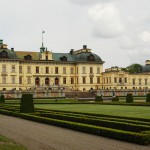Drottningholm Palace. Sweden
This palace is often called Versailles in miniature. It served as a summer residence of the Royal family. Since 1981, the Royal family has been living here permanently.
The name Drottningholm means Queen’s Island. In the XVI century on this spot King Johan III built a castle for his wife, Queen Katarina Jagellonika. This castle stood there for over eighty years before it burnt to the ground on the eve of the New Year of 1662.
Less than in one year, the Dowager Queen Hedvig Eleonora ordered to start building a new palace. A special task was set before its architect. Sweden had just come out of the Thirty Years’ War of 1618-1648 in the heyday of its might, becoming one of the most powerful European states. Queen Eleonora, who was the regent over under-aged King Karl XI, and thus, was the real head of the state, had to have an adequate residence that would match her position. Restored Drottningholm was expected to be such a place.
Architect Nicodemus Tessin the Elder was overseeing the construction works, and after his death in 1682, – his son, Tessin the Younger, took his place.
It is interesting to note that the third generation of the Tessins also served the Swedish art: the son of Tessin the Younger and grandson of Tessin the Elder – Earl Carl Gustav Tessin – with his collection of the French art of the XVIII century founded the corresponding section of the National Museum and brought it fame among European art treasuries.
The palace experienced a new birth in the XVIII century, to be more exact – in 1744. It was among wedding presents to Princess Louisa Ulrika of Prussia on the day of her marriage to Swedish throne heir Adolf Fredrik. Some halls were refashioned according to then popular French Style, and Drottningholm becomes the center of arts and sciences. Within its walls, a court theater opened its doors; prominent scientists of those times stayed in the palace, while visiting. Among them, famous botanist Carl Linnaeus can be named, who spent much time in the vast parks of the royal palace.
Luxurious interiors of the XVII – XIX centuries survived till our days. Apart from that, Drottningholm is a real encyclopedia of landscaping and gardening art. The French Baroque Park has preserved well. Numerous bronze sculptures of Dutch master of the end of XVI–beginning of XVII centuries Adrian de Vries, which were brought to Sweden as trophies from Prague and from Fredriksborg Palace in Denmark, add especial value to it. The French Park in the Classical style, laid out under Gustav III, as well as the Romantic English Park, still fascinate the parks’ visitors.
Since 1766, the Drottningholm Theater preserved practically completely intact. The original theater burnt down during the evening performance in 1762, after being there for only six years. At the order of Lovisa Ulrika, Karl Frederik Aldenkrants built a new theater on the spot of the old one in 1766.
The theater’s building is characterized with simplicity of exterior and interior finishing. Wooden walls of the auditorium are painted to look like marble; pews are hard, without any stuffing.
After its magnificent days in the Gustavian epoch, the theater remained in desolation almost through the entire XIX century. In 1921, its restoration began, in the course of which more than thirty sets of decorations of the XVIII century were discovered, and a complex stage mechanism was rebuilt (it allowed to change decorations before the eyes of the spectators during the performance), chandeliers and lamps were supplied with electricity. In 1922, the Drottningholm Theater opened its doors for public again.
The theater is a “live” museum, where opera and ballet performances are held May through September, as well as concerts in the decorations of the XVIII century.
On the territory of Drottningholm there is a Chinese Pavilion. The first Pavilion was erected here in 1753 and it was presented as a birthday gift to Queen Lovisa Ulrika, mother of Gustav III. It was built in the Chinese style, which was very popular at that time in Europe. Carl Frederik Aldenkrants and Jean Eric Renot worked on the pavilion. Some of the inner facilities of the Chinese Pavilion were done by Yuhan Pasha, while others were executed by Adelcrants as patterns of the stern pre-Gustavian classicism. Among these rooms are the Marble hall, Mirror hall and Room for discourses, which is the central hall of the Chinese Pavilion.
The second pavilion was built ten years later. In its architecture European Rococo style is combined with illusionary admiration of the Chinese themes. Red varnished walls and sculptures on the façade testify of a good knowledge of Chinese architecture, but the main façade of the building is, nevertheless, built in the European style. Unique masterpieces of Chinese and Japanese masters, mostly dated to the XVIII century, are collected in this pavilion.
This collection was initiated in 1777, when Drottningholm was transferred into the state ownership. Most pieces of art preserved perfectly well and are still on display.
A few other pavilions are adjacent to the main building, also built in the Chinese style. One of them – “Confidence” (pronounced in the French way), is a dining hall, where one could eat without any servants around. Waiters, who served at the table, were deaf and could come up to the dining room from the bottom floor only by a signal.

